Sicily
Sicily
| ||
|---|---|---|
|
ISO 3166 code IT-82 | | |
| HDI (2021) | 0.847[4] very high · 21st of 21 | |
| NUTS Region | ITG | |
| Website | www | |


Sicily (Italian: Sicilia, pronounced [siˈtʃiːlja] ; Sicilian: Sicilia, [sɪˈ(t)ʃiːlja] ) is the largest and most populous island in the Mediterranean Sea and one of the 20 regions of Italy. It is one of the five Italian autonomous regions and is officially referred to as Regione Siciliana. The island has 4.8 million inhabitants. Its capital city is Palermo. It is named after the Sicels, who inhabited the eastern part of the island during the Iron Age. Sicily has a rich and unique culture in arts, music, literature, cuisine, and architecture.
Sicily is located in the central Mediterranean Sea, south of the Italian Peninsula in continental Europe; it is separated from Calabria by the Strait of Messina. Its most prominent landmark is Mount Etna, the tallest active volcano in Europe, and is one of the most active in the world, currently 3,357 m (11,014 ft) high. The island has a typical Mediterranean climate.
The earliest archaeological record of human activity on the island is from around 14,000 BC. By around 750 BC, Sicily had three Phoenician and a dozen Greek colonies along its coasts, becoming one of the centers of Magna Graecia. The Sicilian Wars of 580–265 BC were fought between the Carthaginians and Greeks, and the Punic Wars of 264–146 BC were fought between Rome and Carthage. The Roman province of Sicilia ended with the fall of the Roman Empire in the 5th century AD. Sicily was ruled during the Early Middle Ages by the Vandals, the Ostrogoths, the Byzantine Empire, and the Emirate of Sicily.
The Norman conquest of southern Italy led to the creation of the County of Sicily in 1071, that was succeeded by Kingdom of Sicily, a state that existed from 1130 until 1816 under various dynasties,[6][7] and in 1816 it was unified with the Kingdom of Naples into the Kingdom of the Two Sicilies. From the 1282 Sicilian Vespers until the 1860 Expedition of the Thousand, Sicily was ruled by Aragon and then Spain, either in personal union with the crown or by a cadet branch, with the exception of a period of Savoy and then Habsburg rule in 1713–1735.
The island became part of the newly unified Italy in 1860 following the Expedition of the Thousand, an invasion led by Giuseppe Garibaldi, and a plebiscite. Sicily was given special status as an autonomous administrative division on 15 May 1946, 18 days before the 1946 Italian institutional referendum.
Geography
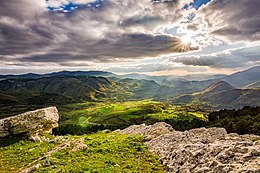
Sicily has a roughly triangular shape, earning it the name Trinacria.
To the north-east, it is separated from
The terrain of inland Sicily is mostly hilly and is intensively cultivated wherever possible. Along the northern coast, the
Sicily and its surrounding small islands have some highly active volcanoes. This is due to Sicily being geographically on the northern edge of the

The Aeolian Islands in the Tyrrhenian Sea, to the northeast of mainland Sicily form a volcanic complex.
The three volcanoes of
From a geographical perspective, also forming a part of Sicily is the Maltese Archipelago, the islands home to the
The autonomous region also includes several neighbouring islands: the Aegadian Islands, the Aeolian Islands, Pantelleria and Lampedusa.
Mountains
The mountains of Sicily form a significant part of the island's diverse landscape, with Mount Etna, one of the world's most active volcanoes, being the highest and most notable peak. Other important mountain ranges include the Nebrodi, Madonie and Peloritani mountains ranges.
Five tallest mountains of Sicily:
| Name | Height (meters) | Height (feet) |
|---|---|---|
| Mount Etna | 3,357 | 11,014 |
| Pizzo Carbonara | 1,979 | 6,493 |
| Monte Soro | 1,853[14] | 6,079 |
| Rocca Busambra | 1,613 | 5,292 |
Monte San Calogero
|
1,326[15] | 4,318 |
Rivers
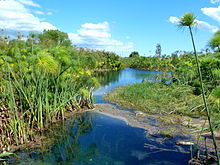
Several rivers drain the island, most of which flow through the central area and enter the sea at the south of the island. The Salso flows through parts of Enna and Caltanissetta before entering the Mediterranean Sea at the port of Licata. To the east, the Alcantara flows through the province of Messina and enters the sea at Giardini Naxos, and the Simeto, which flows into the Ionian Sea south of Catania. Other important rivers on the island are the Belice and Platani in the southwest.
| River | Length |
|---|---|
| Salso | 144 km (89 mi) |
| Simeto | 113 km (70 mi) |
| Belice | 107 km (66 mi) |
| Dittaino | 105 km (65 mi) |
| Platani | 103 km (64 mi) |
| Gornalunga | 81 km (50 mi) |
| Gela | 74 km (46 mi) |
| Salso Cimarosa | 72 km (45 mi) |
| Torto | 58 km (36 mi) |
| Irminio | 57 km (35 mi) |
| Dirillo | 54 km (34 mi) |
| Verdura | 53 km (33 mi) |
| Alcantara | 52 km (32 mi) |
| Tellaro | 45 km (28 mi) |
| Anapo | 40 km (25 mi) |
Climate
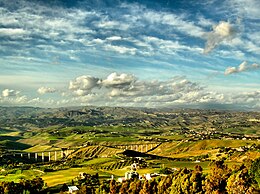
Sicily has for the most part a typical Mediterranean climate (Köppen climate classification: Csa) with mild and wet winters and hot, dry summers with changeable intermediate seasons. On the coasts, especially in the southwest, the climate is affected by the African currents and summers can be hot.
Snow falls above 900 metres, but it can fall in the hills. The interior mountains, especially Nebrodi, Madonie, and Etna, enjoy a mountain climate, with heavy snowfalls during winter. The summit of Mount Etna is usually snow-capped from October to May.
In the summer, the sirocco – the wind from the Sahara – can be felt. Rainfall is scarce, and in some provinces a water crisis can occur.
According to the Regional Agency for Waste and Water, on 10 August 1999, the weather station of Catenanuova (EN) recorded an unofficial maximum temperature of 48.5 °C (119 °F).[16] On 11 August 2021, a new highest temperature record for Europe with a reading of 48.8 °C (119.8 °F) was set near the city of Syracuse.[17] Total precipitation is highly variable, generally increasing with elevation. In general, the southern and southeast coast receives the least rainfall (less than 50 cm (20 in)), and the northern and northeastern highlands the most (over 100 cm (39 in)).
Flora and fauna
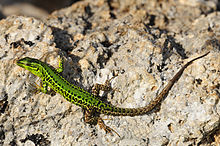
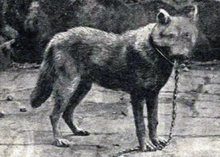
Sicily is an often-quoted example of man-made deforestation, which has occurred since Roman times when the island was turned into an agricultural region.[11] This gradually dried the climate, leading to a decline in rainfall and the drying of rivers. The central and southwest provinces are practically devoid of forest.[18] In Northern Sicily, there are three important forests; near Mount Etna, in the Nebrodi Mountains and in the Bosco della Ficuzza Natural Reserve near Palermo. The Nebrodi Mountains Regional Park, established on 4 August 1993 and covering 86,000 hectares (210,000 acres), is the largest protected natural area of Sicily; it contains the largest forest in Sicily, the Caronia. The Hundred Horse Chestnut (Castagno dei Cento Cavalli), in Sant'Alfio, on the eastern slopes of Mount Etna, is the largest and oldest known chestnut tree in the world at 2,000–4,000 years old.[19]
Sicily has a wide variety of fauna. Species include the
The Riserva naturale dello Zingaro (Zingaro Natural Reserve) is one of the best examples of unspoiled coastal wilderness in Sicily.[24]
History
The name Sicilia was given to the Roman province in 241 BC. It is named after the Sicels, who inhabited the eastern part of the island during the Iron Age.
The ancient name of the island is Trinacria (Greek
Prehistory


Humans first colonized Sicily towards the end of the Late Pleistocene, around 16,000 years ago, by people associated with the Epigravettian culture.[27]
Discoveries of dolmens on the island (dating to the second half of the third millennium BC) seem to offer new insights into the culture of primitive Sicily.[28] The impact of at least two influences is clear: the European one coming from the Northwest, and the Mediterranean influence of an eastern heritage.[29]
Antiquity


The original classical-era inhabitants of Sicily comprised three defined groups of the ancient peoples of Italy: the Sicani, the Elymians and the Sicels. The most prominent and by far the earliest of these were the Sicani, who (Thucydides writes) arrived from the Iberian Peninsula (perhaps Catalonia).[30][31] Some modern scholars, however, suggest classifying the Sicani as possibly an Illyrian tribe.[32] Important historical evidence has been discovered in the form of cave drawings by the Sicani, dated from the end of the Pleistocene epoch around 8000 BC.[33] The Elymians, thought to have come from the area of the Aegean Sea, became the next tribe to join the Sicanians on Sicily.[34]
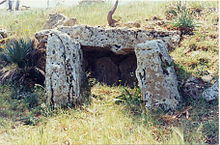
No evidence survives of warring between tribes, but the Sicanians moved eastwards when the Elymians settled in the northwest corner of the island. The
The
Politics on the island became intertwined with those of Greece;

Greek Syracuse controlled eastern Sicily while
In the Second Punic War (218 to 201 BC), the Carthaginians attempted to recapture Sicily. Some of the Greek cities on the island sided with the Carthaginians. Archimedes, who lived in Syracuse, helped the Carthaginians; Roman troops killed him after they invaded Syracuse in 213 BC.[42] The Carthaginian attempt failed, and Rome became more unrelenting in its annihilation of the invaders; Roman consul M. Valerian told the Roman Senate in 210 BC that "no Carthaginian remains in Sicily".[43]
As the Roman Republic's
Various groups used the island as a power base at different times: slave insurgents occupied it during the
Germanic rule (469–535)
The
The Vandals found themselves in a position to threaten Sicily – only 100 miles away from their North African bases.
Byzantine period (535–827)
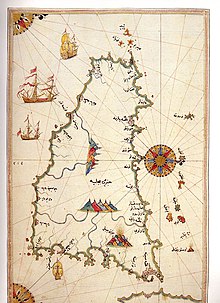
After taking areas occupied by the Vandals in North Africa, Justinian I retook Italy as an ambitious attempt to recover the lost provinces in the West. The re-conquests marked an end to over 150 years of accommodationist policies with tribal invaders. His first target was Sicily (known as the Gothic War (535–554) began between the Ostrogoths and the Eastern Roman Empire, also known as the Byzantine Empire). His general Belisarius was assigned the task.[52] Sicily was used as a base for the Byzantines to conquer the rest of Italy, with Naples, Rome, and Milan. It took five years before the Ostrogoth capital Ravenna fell in 540.[53] However, the new Ostrogoth king Totila counterattacked, moving down the Italian peninsula, plundering and conquering Sicily in 550. Totila was defeated and killed in the Battle of Taginae by Byzantine general Narses in 552 but Italy was in ruins.[53]
At the time of the reconquest Greek was still the predominant language spoken on the island. Sicily was invaded by the
The Eastern Roman Emperor
In 826
The
Arab period (827–1091)
The Arabs initiated land reforms, which increased productivity and encouraged the growth of smallholdings, undermining the dominance of the latifundia. The Arabs further improved irrigation systems. The language spoken in Sicily under Arab rule was Siculo-Arabic and Arabic influence is present in some Sicilian words today. Although long extinct in Sicily, the language has developed into what is now the Maltese language on the islands of Malta today.[60]
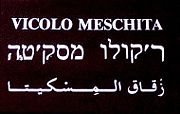
A description of Palermo was given by Ibn Hawqal, an Arab merchant who visited Sicily in 950. A walled suburb, called the Al-Kasr (the palace), is the centre of Palermo to this day, with the great Friday mosque on the site of the later Roman cathedral. The suburb of al-Khalisa (modern Kalsa) contained the Sultan's palace, baths, a mosque, government offices, and a private prison. Ibn Hawqal estimated there were 7,000 butchers trading in 150 shops. During Muslim rule agricultural products such as oranges, lemons, pistachios and sugarcane were brought to Sicily.[46] Western Sicily was overwhelmingly Muslim, and contained large plantations run by slave labor, often producing sugar.[59] Around 1050, the western half of Sicily was ethnically and culturally distinct from central and eastern Sicily. During this time, there was also a small Jewish presence in Sicily, evidence seen in the catacombs discovered on the island[61][62]
Palermo was initially ruled by the
Norman Sicily (1038–1198)
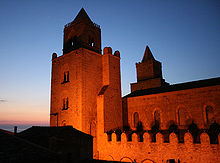
In 1038, seventy years after losing their last cities in Sicily, the Byzantines under the Greek general
The Norman Hauteville family, descendants of Vikings, appreciated and admired the rich and layered culture in which they now found themselves. They also introduced their own culture, customs, and politics in the region. Many Normans in Sicily adopted the habits and comportment of Muslim rulers and their Byzantine subjects in dress, language, literature, even to the extent of having palace eunuchs and, according to some accounts, a harem.[65][66]
While Roger I died in 1101, his wife
Roger II appointed the powerful Greek George of Antioch to be his "emir of emirs" and continued the syncretism of his father. During this period, the Kingdom of Sicily was prosperous and politically powerful, becoming one of the wealthiest states in all of Europe—even wealthier than the Kingdom of England.[68]
The court of Roger II became the most luminous centre of culture in the Mediterranean, both from Europe and the Middle East, like the multi-ethnic Caliphate of Córdoba, then only just eclipsed. This attracted scholars, scientists, poets, artists, and artisans of all kinds. Laws were issued in the language of the community to whom they were addressed in Norman Sicily, at the time when the culture was still heavily Arab and Greek.[69][70] Governance was by rule of law which promoted justice. Muslims, Jews, Byzantine Greeks, Lombards, and Normans worked together fairly amicably. During this time many extraordinary buildings were constructed.[69]
However this situation changed as the Normans imported immigrants from
Kingdom of Sicily (1198–1860)

After a century, the Norman
Conflict between the Hohenstaufen house and the

Strong opposition to French officialdom due to mistreatment and taxation saw the local peoples of Sicily rise up, leading in 1282 to an
In October 1347, in Messina, Sicily, the Black Death first arrived in Europe.[74]
Between the 15th and 18th centuries, waves of

The onset of the
While the Austrians were concerned with the
Following this, Sicily joined the
Italian unification
The
The Sicilian economy (and the wider
This period was also characterized by the first contact between the
20th and 21st centuries
In the 1920s, the
Italy
The Cosa Nostra has traditionally been the most powerful group in Sicily, especially around Palermo.[94] A police investigation in summer 2019 also confirmed strong links between the Palermo area Sicilian Mafia and American organized crime, particularly the Gambino crime family.[95] According to La Repubblica, "Off they go, through the streets of Passo di Rigano, Boccadifalco, Torretta and at the same time, Brooklyn, Staten Island, [and] New Jersey. Because from Sicily to the US, the old mafia has returned".[96]
Demographics
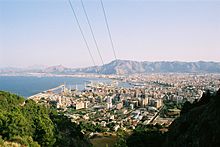
| Year | Pop. | ±% |
|---|---|---|
| 1861 | 2,409,000 | — |
| 1871 | 2,590,000 | +7.5% |
| 1881 | 2,933,000 | +13.2% |
| 1901 | 3,568,000 | +21.7% |
| 1911 | 3,812,000 | +6.8% |
| 1921 | 4,223,000 | +10.8% |
| 1931 | 3,906,000 | −7.5% |
| 1936 | 4,000,000 | +2.4% |
| 1951 | 4,486,749 | +12.2% |
| 1961 | 4,721,001 | +5.2% |
| 1971 | 4,680,715 | −0.9% |
| 1981 | 4,906,878 | +4.8% |
| 1991 | 4,966,386 | +1.2% |
| 2001 | 4,968,991 | +0.1% |
| 2011 | 5,002,904 | +0.7% |
| 2021 | 4,833,329 | −3.4% |
| Source: ISTAT | ||
About five million people live in Sicily, making it the
Emigration

Sicilian emigration started shortly after the
The aforementioned factors, along with a failed land reform, resulted in a never-before-seen wave of Sicilians emigrating, first to the United States between the 1880s and the 1920s, later to Northern Italy, and from the 1960s onwards also to Belgium, France, Germany, Switzerland, as well as Australia and South America.
Today, Sicily is the Italian region with the highest number of expatriates: as of 2017, 750,000 Sicilians, 14.4% of the island's population, lived abroad.[104] For lack of employment, every year many Sicilians, especially young graduates, still leave the island to seek jobs abroad.[105] Today, an estimated 10 million people of Sicilian origins live around the world.
Largest cities
| Rank | Name | Pop. (2017) | Area (km2) | Pop. per km2 |
|---|---|---|---|---|
| 1 | Palermo | 668,405 | 159 | 4,207 |
| 2 | Catania | 311,620 | 181 | 1,723 |
| 3 | Messina | 234,293 | 212 | 1,107 |
| 4 | Syracuse | 121,605 | 204 | 596 |
| 5 | Marsala | 82,802 | 242 | 343 |
| 6 | Gela | 74,858 | 277 | 270 |
| 7 | Ragusa | 73,638 | 442 | 166 |
| 8 | Trapani | 67,923 | 272 | 250 |
| 9 | Vittoria | 64,212 | 181 | 354 |
| 10 | Caltanissetta | 62,317 | 416 | 150 |
Religion

As in most Italian regions,
Politics
The politics of Sicily takes place in a framework of a
Traditionally, Sicily votes for centre-right parties during elections.
Administrative divisions
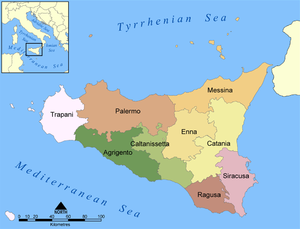
Administratively, Sicily is divided into nine provinces, each with a capital city of the same name as the province. Small surrounding islands are also part of various Sicilian provinces: the
| Province | Area (km2) |
Population[110] | Density (Pop. per km2) |
Number of communes |
|---|---|---|---|---|
| Agrigento | 3,042 | 453,594 | 149.1 | 43 |
| Caltanissetta | 2,128 | 271,168 | 127.4 | 22 |
| Catania | 3,552 | 1,090,620 | 307.0 | 58 |
| Enna | 2,562 | 172,159 | 67.2 | 20 |
| Messina | 3,247 | 652,742 | 201.0 | 108 |
| Palermo | 4,992 | 1,249,744 | 250.3 | 82 |
| Ragusa | 1,614 | 318,980 | 197.6 | 12 |
Siracusa
|
2,109 | 403,559 | 191.3 | 21 |
| Trapani | 2,460 | 436,240 | 177.3 | 24 |
Economy

Thanks to regular growth in recent years, Sicily is the eighth largest regional economy of Italy in terms of total GDP (see
Agriculture

Sicily has long been noted for its fertile soil, which is the result of past volcanic eruptions. The local agriculture is also helped by the pleasant climate of the island. The main agricultural products are wheat,
Sicily is the third largest wine producer in Italy, after
Sicily is also known for its liqueurs, such as Amaro Averna, produced in Caltanissetta, and the local limoncello.
Fishing is another fundamental resource for Sicily. It has important tuna, sardine, swordfish and European anchovy fisheries. Mazara del Vallo is the largest fishing centre in Sicily and one of the most important in Italy.[124]
Industry and manufacturing

Improvements in Sicily's road system have helped to promote industrial development. The region has three important industrial districts:
- food industries and one of the best European electronics industry centres called Etna Valley (in honour of the best known Silicon Valley) which contains offices and factories of international companies such as STMicroelectronics and Numonyx;[124][125]
- power stations (as the innovative Archimede combined cycle power plant);[126]
- the latest food industries.[127]
In
Statistics
GDP growth
Sicily's GDP (nominal and per capita) growth between 2000 and 2008 was as follows:[130][131]
| 2000 | 2001 | 2002 | 2003 | 2004 | 2005 | 2006 | 2008 | |
|---|---|---|---|---|---|---|---|---|
| Gross Domestic Product (Millions of Euros) |
67,204 | 70,530 | 72,855 | 75,085 | 77,327 | 80,358 | 82,938 | 88,328 |
| GDP (PPP) per capita (Euro) |
13,479 | 14,185 | 14,662 | 15,053 | 15,440 | 16,023 | 16,531 | 17,533 |
Economic sectors
Sectors of the Sicilian economy in 2006:
| Economic activity | GDP € millions |
% sector (Sicily) |
% sector (Italy) |
|---|---|---|---|
| Agriculture, farming, fishing | 2,923.3 | 3.52% | 1.84% |
| Industry | 7,712.9 | 9.30% | 18.30% |
| Constructions | 4,582.1 | 5.52% | 5.41% |
| Commerce, hotels and restaurants, transport, services and (tele)communications | 15,159.7 | 18.28% | 20.54% |
| Financial activity and real estate | 17,656.1 | 21.29% | 24.17% |
| Other economic activities | 24,011.5 | 28.95% | 18.97% |
| VAT and other forms of taxes | 10,893.1 | 13.13% | 10.76% |
| GDP of Sicily | 82,938.6 |
Unemployment rate
The unemployment rate was 21.5% in 2018 and was one of the highest in Italy and Europe.[132][133]
| Year | 2006 | 2007 | 2008 | 2009 | 2010 | 2011 | 2012 | 2013 | 2014 | 2015 | 2016 | 2017 | 2018 |
|---|---|---|---|---|---|---|---|---|---|---|---|---|---|
| Unemployment rate | 13.4% | 12.9% | 13.7% | 13.8% | 14.6% | 14.3% | 18.4% | 21.0% | 22.2% | 21.4% | 22.1% | 21.5% | 21.5% |
Transport
Roads
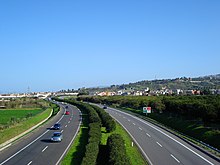

Highways have been built and expanded in the last four decades. The most prominent Sicilian roads are the motorways (known as autostrade) in the north of the island. Much of the motorway network is elevated on pillars due to the island's mountainous terrain.).
| Sign | Motorway | Length | Toll | Services |
|---|---|---|---|---|
| A18 Messina-Catania | 76 km (47 mi) | |||
| RA15 Catania's Bypass (West) | 24 km (15 mi) | Free | ||
| Motorway Catania-Siracusa | 25 km (16 mi) | Free | No | |
| A18 Siracusa-Rosolini | 40 km (25 mi) | Free | No | |
| A19 Palermo-Catania | 199 km (124 mi) | Free | ||
| A20 Palermo-Messina | 181 km (112 mi) | |||
| A29 Palermo-Mazara del Vallo | 119 km (74 mi) | Free | No | |
| A29dir Alcamo-Trapani/Marsala | 38 km (24 mi) and 44 km (27 mi) |
Free | No |
Railways


The first railway in Sicily was opened in 1863 (Palermo-Bagheria) and today all of the Sicilian provinces are served by a network of railway services, linking to most major cities and towns; this service is operated by
In
Airports

Sicily has several airports that serve numerous Italian and European destinations and some extra-European.
- Catania-Fontanarossa Airport, located on the east coast, is the busiest on the island (and one of the busiest in all of Italy).
- Palermo International Airport, which is also a substantially large airport with many national and international flights.
- Trapani-Birgi Airport, a military-civil joint-use airport (third for traffic on the island). Recently the airport has seen an increase in traffic thanks to a low-cost carrier.
- Comiso-Ragusa Airport, has recently been refurbished and re-converted from military use to a civil airport. It was opened to commercial traffic and general aviation on 30 May 2013.
- police helicopters.
- NAS Sigonella Airport, it is an Italian Air Force and US Navy installation.
- Lampedusa Airport.
- Pantelleria Airport.
Ports
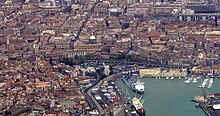
By sea, Sicily is served by several ferry routes and cargo ports, and in all major cities, cruise ships dock on a regular basis.
- Mainland Italy: Ports connecting to the mainland are Messina (route to Villa San Giovanni and Salerno), the busiest passenger port in Italy, Palermo (routes to Genoa, Civitavecchia and Naples) and Catania (route to Naples).
- Sicily's small surrounding islands: The port of Milazzo serves the Aeolian Islands, the ports of Trapani and Marsala the Aegadian Islands and the port of Porto Empedocle the Pelagie Islands. From Palermo there is a service to the island of Ustica and to Sardinia.
- International connections: From Palermo and Trapani there are weekly services to Tunisia and there is also a daily service between Malta and Pozzallo.[139][140]
- Commercial and cargo ports: The port of Augusta is the fifth-largest cargo port in Italy and handles tonnes of goods. Other major cargo ports are Palermo, Catania, Trapani, Pozzallo and Termini Imerese.
- Touristic ports: Several ports along the Sicilian coast are in the service of private boats that need to moor on the island. The main ports for this traffic are in Marina di Ragusa, Riposto, Portorosa, Syracuse, Cefalù and Sciacca. In Sicily, Palermo is also a major centre for boat rental, with or without crew, in the Mediterranean.
- Fishing ports: Like all islands, Sicily also has many fishing ports. The most important is in .
Planned bridge
Plans for a bridge linking Sicily to the mainland have been discussed since 1865. Throughout the last decade, plans were developed for a road and rail link to the mainland via what would be the world's longest suspension bridge, the Strait of Messina Bridge. Planning for the project has experienced several false starts over the past few decades. On 6 March 2009, Silvio Berlusconi's government declared that the construction works for the Messina Bridge would begin on 23 December 2009, and announced a pledge of €1.3 billion as a contribution to the bridge's total cost, estimated at €6.1 billion.[141] The plan has been criticized by environmental associations and some local Sicilians and Calabrians, concerned with its environmental impact, economic sustainability and even possible infiltrations by organized crime.[142][143]
Tourism

Sicily's sunny, dry climate, scenery, cuisine, history, and architecture attract many tourists from the rest of Italy and abroad. The tourist season peaks in the summer months, although people visit the island all year round. Mount Etna, the beaches, the archaeological sites, and major cities such as Palermo, Catania, Syracuse and Ragusa are the favourite tourist destinations, but the old town of Taormina and the neighbouring seaside resort of Giardini Naxos draw visitors from all over the world, as do the Aeolian Islands, Erice, Terrasini, Castellammare del Golfo, Cefalù, Agrigento, the Pelagie Islands and Capo d'Orlando. The last features some of the best-preserved temples of the ancient Greek period. Many Mediterranean cruise ships stop in Sicily, and many wine tourists also visit the island.
Some scenes of several Hollywood and Cinecittà films were shot in Sicily. This increased the attraction of Sicily as a tourist destination.[144]
UNESCO World Heritage Sites
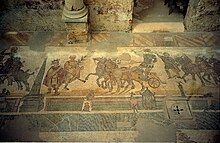
There are seven
- Valle dei Templi (1997) is one of the most outstanding examples of Magna Graecia art and architecture, and is one of the main attractions of Sicily as well as a national monument of Italy. The site is located in Agrigento.[145]
- Villa Romana del Casale (1997) is a Roman villa built in the first quarter of the 4th century and located about 3 km (2 mi) outside the town of Piazza Armerina. It contains the richest, largest and most complex collection of Roman mosaics in the world.[146]
- Aeolian Islands (2000) are a volcanic archipelago in the Tyrrhenian Sea, named after the demigod of the winds Aeolus. The Aeolian Islands are a tourist destination in the summer, and attract up to 200,000 visitors annually.[147]
- Ragusa and Scicli.
- Necropolis of Pantalica (2005) is a large Necropolis in Sicily with over 5,000 tombs dating from the 13th to the 7th centuries BC. Syracuse is notable for its rich Greek history, culture, amphitheatres and architecture. They are situated in south-eastern Sicily.
- Mount Etna (2013) is one of the most active volcanoes in the world and is in an almost constant state of activity and generated myths, legends and naturalistic observation from Greek, Celts and Roman classic and medieval times.[149]
- Arab-Norman Palermo and the cathedral churches of Cefalù and Monreale; includes a series of nine civil and religious structures dating from the era of the Norman kingdom of Sicily (1130–1194)[150]

Tentative UNESCO World Heritage sites

- Taormina and Isola Bella;[151]
- Motya and Libeo Island: The Phoenician-Punic Civilisation in Italy;[152]
- Scala dei Turchi;[153]
- Strait of Messina.[154]
Archeological sites
Because many different cultures settled, dominated or invaded the island, Sicily has a huge variety of
- Sicels/Sicans/Elymians/Greeks: Pantalica;
- Greeks: Syracuse, Agrigento, Segesta, Selinunte, Gela, Kamarina, Himera, Megara Hyblaea, Naxos, Heraclea Minoa;
- Phoenicians: Motya, Soluntum, Marsala, Palermo;
- Romans: Piazza Armerina, Centuripe, Taormina, Palermo;
The excavation and restoration of one of Sicily's best known archaeological sites, the Valley of the Temples in Agrigento, was at the direction of the archaeologist Domenico Antonio Lo Faso Pietrasanta, Fifth Duke of Serradifalco, known in archaeological circles simply as "Serradifalco". He also oversaw the restoration of ancient sites at Segesta, Selinunte, Siracusa and Taormina.
Castles
In Sicily there are hundreds of castles, the most relevant are:
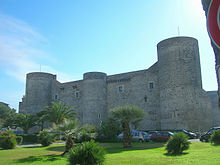


| Province | Castles | Commune |
|---|---|---|
| Caltanisetta | Castello Manfredonico | Mussomeli |
| U Cannuni | Mazzarino | |
| Castelluccio di Gela | Gela | |
| Catania | Castello Ursino | Catania |
| Castello Normanno | Adrano | |
| Castello Normanno | Paternò | |
| Castello di Aci | Aci Castello | |
| Enna | Castello di Lombardia | Enna |
| Messina | Forte dei Centri | Messina |
| Castello di Milazzo | Milazzo | |
| Castello di Federico II | Montalbano Elicona | |
| Castello di Sant'Alessio Siculo | Sant'Alessio Siculo | |
| Castello di Pentefur | Savoca | |
| Castello di Schisò | Giardini Naxos | |
| Palermo | Zisa, Palermo | Palermo |
| Castello di Caccamo | Caccamo | |
| Castello di Carini | Carini | |
| Castello dei Ventimiglia | Castelbuono | |
| Ragusa | Castello di Donnafugata | Ragusa
|
| Torre Cabrera | Pozzallo | |
| Castello Dei Conti | Modica | |
| Syracuse | Castello Maniace | Syracuse |
| Castello Svevo | Augusta | |
| Trapani | Castello di Venere | Erice |
| Castle of the Counts of Modica | Alcamo | |
Castle of Calatubo
|
Alcamo |
Coastal towers
The Coastal towers in Sicily (Torri costiere della Sicilia) are 218 old
Most existing towers were built on architectural designs of the Florentine architect
-
Torre-Capo-Rama (Terrasini)
-
Torre Normanna (Altavilla Milicia)
-
Torre Spalmatore (Ustica)
-
Torre Pozzillo (Cinisi)
-
Torre Nubia (Paceco)
Historical villages
Sicily has many small and picturesque villages, 24 of them have been selected by I Borghi più belli d'Italia (English: The most beautiful Villages of Italy),[157] a non-profit private association of small Italian towns of strong historical and artistic interest,[158] that was founded on the initiative of the Tourism Council of the National Association of Italian Municipalities.[159]
Culture
To have seen Italy without having seen Sicily is to not have seen Italy at all, for Sicily is the clue to everything.
—better source needed]

Sicily has long been associated with the arts; many poets, writers, philosophers, intellectuals, architects and painters have roots on the island. The history of prestige in this field can be traced back to Greek philosopher Archimedes, a Syracuse native who has gone on to become renowned as one of the greatest mathematicians of all time.[161] Gorgias and Empedocles are two other highly noted early Sicilian-Greek philosophers, while the Syracusan-Greek Epicharmus is held to be the inventor of comedy.[162][163]
Art and architecture
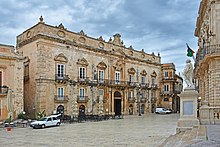
Baglio are traditional living structures in Western Sicily.
Ceramics
Sicilian Baroque

The
Music and film
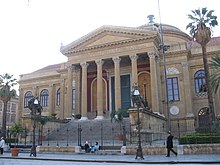
Palermo hosts the Teatro Massimo which is the largest opera house in Italy and the third largest in all of Europe.[167] In


Many award-winning and acclaimed films of Italian cinema have been filmed in Sicily, amongst the most noted of which are:
".Literature

The golden age of Sicilian poetry began in the early 13th century with the
Languages
Today, in Sicily, most people are bilingual and speak both
Sicilian was an early influence in the development of the first Italian standard, although its use remained confined to an intellectual elite. This was a literary language in Sicily created under the auspices of Frederick II and his court of notaries, or Magna Curia, which, headed by Giacomo da Lentini, also gave birth to the Sicilian School, widely inspired by troubadour literature. Its linguistic and poetic heritage was later assimilated into the literary Florentine dialect use by Dante Alighieri, the father of modern Italian. Dante, in his De vulgari eloquentia, claims that "In effect, this vernacular seems to deserve higher praise than the others since all the poetry written by Italians can be called Sicilian".[173] It is in this language that appeared the first sonnet, whose invention is attributed to Giacomo da Lentini himself.
Other languages are spoken in Sicily. Within the province of Palermo, four towns are home to speakers of Arbërësh varieties.[174] Arbërësh is the name given to varieties of Albanian spoken in Italy. In the eastern part of the island, there are Gallo-Italic varieties known as Gallo-Italic of Sicily,[175][176] which are related to the other Gallo-Italic languages spoken in most of northern Italy and in other isolated pockets of southern Italy.
Science

Education
Sicily has four universities:
- The University of Catania dates back to 1434 and it is the oldest university in Sicily. Nowadays it hosts 12 faculties and over 62,000 students and it offers undergraduate and postgraduate programs. Catania hosts also the Scuola Superiore, an academic institution linked to the University of Catania, aiming for excellence in education.[185]
- The University of Palermo is the island's second-oldest university. It was officially founded in 1806, although historical records indicate that medicine and law have been taught there since the late 15th century. The Orto botanico di Palermo (Palermo botanical gardens) is home to the university's Department of Botany and is also open to visitors.
- The University of Messina, founded in 1548 by Ignatius of Loyola. It is organized in 11 Faculties.
- The Italian Unification.
Cuisine
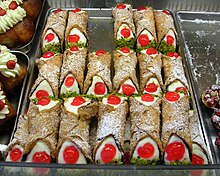
The island has a long history of producing a variety of noted cuisines and wines, to the extent that Sicily is sometimes nicknamed God's Kitchen because of this.
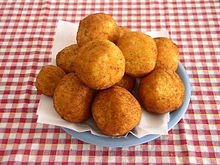
The most well-known part of Sicilian cuisine is the rich sweet dishes including
Like the cuisine of the rest of southern Italy, pasta plays an important part in Sicilian cuisine, as does rice; for example with
Sports
The most popular sport in Sicily is
Palermo and Catania have a heated rivalry and compete in the
Although football is the most popular sport in Sicily, the island also has participants in other fields.
From 28 September to 9 October 2005 Trapani was the location of Acts 8 and 9 of the Louis Vuitton Cup. This sailing race featured, among other entrants, all boats that took part in the 2007 America's Cup.
Popular culture


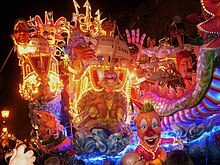
Each town and city has its own patron saint, and the
Sicilian religious festivals also include the presepe vivente (living nativity scene), which takes place at Christmas time. Deftly combining religion and folklore, it is a constructed mock 19th-century Sicilian village, complete with a nativity scene, and has people of all ages dressed in the costumes of the period, some impersonating the Holy Family, and others working as artisans of their particular assigned trade. It is normally concluded on Epiphany, often highlighted by the arrival of the magi on horseback.
Oral tradition plays a large role in Sicilian folklore. Many stories passed down from generation to generation involve a character named "Giufà". Anecdotes from this character's life preserve Sicilian culture as well as convey moral messages.
Sicilians also enjoy outdoor festivals, held in the local square or piazza where live music and dancing are performed on stage, and food fairs or sagre are set up in booths lining the square. These offer various local specialties, as well as typical Sicilian food. Normally these events are concluded with fireworks. A noted sagra is the Sagra del Carciofo or Artichoke Festival, which is held annually in Ramacca in April. The most important traditional event in Sicily is the carnival. Famous carnivals are in Acireale, Misterbianco, Regalbuto, Paternò, Sciacca, Termini Imerese.
The
Today, there are only a few troupes that maintain the tradition. They often perform for tourists. However, there are no longer the great historical families of marionettists, such as the Greco of
Traditional items

The Sicilian cart is an ornate, colourful style of a horse- or donkey-drawn cart native to Sicily. Sicilian woodcarver George Petralia states that horses were mostly used in the city and flat plains, while donkeys or mules were more often used in rough terrain for hauling heavy loads.[197] The cart has two wheels and is primarily handmade out of wood with iron components.
The Sicilian
Flag and emblem


The Flag of Sicily, regarded as a regional icon, was first adopted in 1282, after the Sicilian Vespers of Palermo.[199] It is characterised by the presence of the triskeles in the middle, depicting the head of Medusa and three wheat ears representing the extreme fertility of the land of Sicily. In early mythology, when Medusa was slain and beheaded by Perseus, the Medusa head was placed in the centre of Athena's shield.[200]
Palermo and Corleone were the first two cities to found a confederation against the Angevin rule. The triskeles symbol came to be on the Sicilian flag in 1943 during World War II when Andrea Finocchiaro Aprile led an independence movement, in collaboration with the allies. Their plan was to help Sicily become independent and form a free republic. The colours, likewise introduced in the 1940s, respectively represent the cities of Palermo and Corleone. The separatist behind the movement used a yellow and red flag with the Trinacria in the centre of it. When World War II ended, Sicily was recognized as an autonomous region in the Italian Republic.
The flag became the official public flag of the Regione Siciliana in January 2000, after the passing of an apposite regional law which advocates its use on public buildings, schools and city halls along with the national
Familiar as an ancient symbol of the region, the
See also
References
- ^ "Statistiche demografiche ISTAT". Demo.istat.it. Archived from the original on 24 July 2019. Retrieved 16 June 2020.
- ^ "Region Sicilia".
- ^ "Population on 1 January by age, sex and NUTS 2 region", www.ec.europa.eu
- ^ "Sub-national HDI – Area Database – Global Data Lab". hdi.globaldatalab.org. Retrieved 5 March 2023.
- ^ "Statistiche demografiche ISTAT". Demo.istat.it. Archived from the original on 24 July 2019. Retrieved 16 June 2020.
- ^ Pasquale Hamel – L' invenzione del regno. Dalla conquista normanna alla fondazione del Regnum Siciliae (1061–1154)
- ^ "Sicilia nell'Enciclopedia Treccani". www.treccani.it (in Italian). Retrieved 22 December 2020.
- ^ Britannica – Travel & Geography – Sicily Italian Sicilia – retrieved 11 May 2010.
- ^ "Territory and Environment" (PDF). Official page of the Region of Sicily. Retrieved 25 March 2013.
{{cite journal}}: Cite journal requires|journal=(help) - ^ "Regioni d'Italia: Sicily". Italia Tourism Online. Archived from the original on 15 March 2013. Retrieved 25 March 2013.
{{cite journal}}: Cite journal requires|journal=(help) - ^ ISBN 978-0-470-39899-9.
- ISSN 0012-821X.
- S2CID 238802288.
- ^ PeakVisor. "Monte Soro". PeakVisor. Retrieved 4 April 2024.
- ^ "Monte San Calògero : Climbing, Hiking & Mountaineering : SummitPost". www.summitpost.org. Retrieved 4 April 2024.
- ^ "Agenzia Regionale per i Rifiuti e le Acque". Osservatorio delle Acque. Archived from the original on 22 July 2011. Retrieved 14 October 2010.
- ^ "WMO is monitoring potential new temperature records". public.wmo.int. 17 July 2023. Retrieved 17 July 2023.
- ^ Trabia, Carlo (2002). "A Sicilian Desert?". Best of Sicily Magazine.
- ^ Lillie, Barry (5 April 2014). "The Chestnut Tree of One Hundred Horses: Sicily's Most Famous Tree". Italy Magazine.
- hdl:10447/514729.
- ^ Sicilia, flora e fauna-Specie vegetali e animali in Sicilia. Insicilia.org. Retrieved on 18 December 2012.
- .
- S2CID 225710152.
- ^ "RISERVA DELLO ZINGARO". Visit Sicily. 7 October 2015.
- ^ Cassell's Latin Dictionary, Marchant, J.R.V, & Charles, Joseph F., (Eds.), Revised Edition, 1928
- ^ "Sicilian Culture: The Folklore, Legends & Traditions: Trinacria." Sicilian Culture: The Folklore, Legends & Traditions: Trinacria. N.p., n.d. Web. 9 November 2014. "Sicily." Sicily. N.p., n.d. Web. 10 November 2014.
- S2CID 250926924.
- ISBN 9780956510624. Retrieved 17 October 2013.
- ^ Ibidem, p. 31.
- ^ "The Sicani and agriculture". Antropocene. 5 June 2023.
- ^ "Aapologetico de la literatura española contra los opiniones". Ensayo historico. 7 October 2007.
- ISBN 9780674033146.
most scholars now believe that the sicans and Sicels, as well as the.
- ^ a b c "Sicilian Peoples: The Sicanians". Best of Sicily. 7 October 2007.
- ^ "Sicani". Britannica.com. 7 October 2007.
- ^ a b c Herbermann, Charles, ed. (1913). . Catholic Encyclopedia. New York: Robert Appleton Company.
- ^ E. Zuppardo-S.Piccolo, Terra Mater: sulle sponde del Gela greco, Betania Ed., Caltanissetta 2005
- ^ a b c "History of Sicily". knowital.com. 7 October 2007. Archived from the original on 1 August 2003.
- ^ "Valley of the Temples". Italiansrus.com. 7 October 2007.
- ^ "Siege of Syracuse". Livius.org. 7 October 2007. Archived from the original on 7 November 2016. Retrieved 26 March 2020.
- ISBN 978-0-143-12129-9.
- ^ "Sicily". Hutchinson Encyclopedia. 7 October 2007. Archived from the original on 2 December 2008.
- ^ Miles, Richard (2010). Carthage Must Be Destroyed. New York: Viking.
- .
- OCLC 1301799183 – via Google Books.
- ^ a b "Early & Medieval History". BestofSicily.com. 7 October 2007.
- ^ ISBN 978-0-7818-0909-2.
- ^ J.B. Bury, History of the Later Roman Empire, 1958 edition, p. 254
- ^ Bury, p. 327.
- ^ Bury, pp. 410, 425.
- ^ "Theodoric". Encyclopædia Britannica. 7 October 2007.
- ^
Frassetto, Michael (2003), Encyclopedia of Barbarian Europe: Society in Transformation. Santa Barbara, CA, p. 335: ABC-CLIO. ISBN 978-1-57607-263-9.
- ISBN 978-0-521-33719-9.
- ^ a b "Gothic War: Byzantine Count Belisarius Retakes Rome". Historynet.com. 7 October 2007. Archived from the original on 2 November 2007.
- ISBN 978-0-19-504652-6.
- JSTOR 10.7591/j.ctt1qv5qfp.
- ^ a b "Syracuse, Sicily". TravelMapofSicily.com. 7 October 2007. Archived from the original on 6 June 2008. Retrieved 4 December 2007.
- ^ "Sicilian Peoples: The Byzantines". BestofSicily.com. 7 October 2007.
- ^ Treadgold. History of the Byzantine State, pp. 354–355.
- ^ a b c d e f g "Brief history of Sicily" (PDF). Archaeology.Stanford.edu. 7 October 2007. Archived from the original (PDF) on 9 June 2007.
- ISSN 0013-0613. Retrieved 26 October 2022.
- ^ Raphael Patai, The Jewish Mind, Scribners, 1977, p. 155–6
- ^ "Jewish Catacombs of Venosa". Visit Jewish Italy. Retrieved 25 April 2024.
- ^ a b "Italy during the Crusades – Sicily under the Normans" – History of the Crusades – Boise State University – Retrieved 15 July 2011.
- ^ a b "Chronological – Historical Table of Sicily". In Italy Magazine. 7 October 2007. Archived from the original on 27 July 2016. Retrieved 12 December 2007.
- ISBN 978-0-521-81692-2.
- ISBN 978-90-04-09920-3.
- ^ "Classical and Medieval Malta (60–1530)". AboutMalta.com. 7 October 2007.
- ISBN 978-0-14-015212-8.
- ^ a b "Norman Sicily of the 12th Century" – Inter-American Institute for Advanced Studies in Cultural History – Retrieved 15 July 2011.
- ^ ISBN 0-521-25551-1" "At the end of the twelfth-century ... While in Apulia Greeks were in a majority – and indeed present in any numbers at all – only in the Salento peninsula in the extreme south, at the time of the conquest they had an overwhelming preponderance in Lucaina and central and southern Calabria, as well as comprising anything up to a third of the population of Sicily, concentrated especially in the north-east of the island, the Val Demone.
- ^ "Sicilian Peoples: The Normans". BestofSicily.com. 7 October 2007.
- ^ a b c d e f Dieli, Art (8 July 2015). "Sicilian History: An Abbreviated Chronology". Dieli.net.
- ISBN 9780739157978– via Google Books.
- ^ Snell, Melissa (30 July 2019). "The Arrival and Spread of the Black Plague in Europe". ThoughtCo. Retrieved 24 January 2024.
- ^ "Italy's earthquake history". BBC News. 31 October 2002.
- ^ Rees Davies, British Slaves on the Barbary Coast, BBC, 1 July 2003
- ISBN 1-4039-4551-9
- ^ "The Treaties of Utrecht (1713)". Heraldica.org. 7 October 2007.
- ^ "Charles of Bourbon – the restorer of the Kingdom of Naples". RealCasaDiBorbone.it. 7 October 2007. Archived from the original on 4 August 2003.
- ^ "Campo Tenese". Clash-of-Steel.co.uk. 7 October 2007.
- ^ Regno Delle Due Sicilie nell'Enciclopedia Treccani. Treccani.it. Retrieved on 18 December 2012.
- ^ a b c "Italians around the World: Teaching Italian Migration from a Transnational Perspective". OAH.org. 7 October 2007. Archived from the original on 27 November 2010.
- ^ Sicily (island, Italy) – Britannica Online Encyclopaedia. Britannica.com. Retrieved on 18 December 2012.
- ^ "Sicily". Capitol Hill. 7 October 2007. Archived from the original on 18 October 2007.
- ^ "fascio siciliano". Encyclopædia Britannica. 7 October 2007.
- ^ "Messina earthquake and tsunami". Britannica Online Encyclopedia.
- ^ Arma dei Carabinieri – Home – L'Arma – Ieri – Storia – Vista da – Fascicolo 22. Carabinieri.it. Retrieved on 18 December 2012.
- ^ "Modern Sicilian History & Society". BestofSicily.com.
- ^ "Sicily autonomy". Grifasi-Sicilia.com. 7 October 2007.
- ^ "Le spinte e i ritorni": gli anni delle riforme per lo sviluppo in Sicilia (1947–1967)". Storicamente.org (in Italian). Archived from the original on 24 May 2013. Retrieved 18 December 2012.
- ^ "Due eroi italiani – Materiali didattici di Scuola d'Italiano Roma a cura di Roberto Tartaglione". Scudit.net (in Italian). 11 April 2004. Retrieved 18 December 2012.
- ^ "Italy – Land Reforms". Encyclopædia Britannica. 7 October 2007.
- ^ "Sicilia". Istat.it (in Italian). Archived from the original on 15 November 2012. Retrieved 18 December 2012.
- ^ Pantaleone, Wladimir (4 December 2018). "Italy police arrest alleged new mafia boss in Sicily". Global News. Retrieved 22 June 2021.
- ^ Messia, Hada; Kent, Lauren (17 July 2019). "19 mafia suspects arrested in joint transatlantic raids". CNN. Retrieved 22 June 2021.
- ^ Giuffrida, Angela (17 July 2019). "FBI and Italian police arrest 19 people in Sicily and US in mafia investigation". The Guardian. Retrieved 22 June 2021.
- ^ "Statistiche demografiche ISTAT". Demo.istat.it. Archived from the original on 30 June 2016. Retrieved 29 May 2016.
- ^ "Bilancio demografico anno 2017 Regione: Sicilia". demo.istat.it. 2017. Archived from the original on 19 October 2019. Retrieved 14 September 2017.
- ^ "Bilancio demografico popolazione straniera".
- ^ "Legge 482". camera.it. Archived from the original on 12 May 2015. Retrieved 28 February 2013.
- ^ "Corriere della Sera – Italia, quasi l'88% si proclama cattolico". corriere.it.
- ISSN 2282-5681.
- ^ "La questione meridionale 3/ Il saccheggio del Banco delle due Sicilie". 9 December 2017.
- ^ "Disastro Sicilia: In fuga i suoi figli". 31 October 2017.
- ^ "Emigrazione, fuga dalla Sicilia: Ogni anno cancellato un paese di ventimila abitanti". 29 January 2016.
- ^ "Sicilia / Sicily (Italy): Provinces, Major Cities & Communes – Population Statistics, Maps, Charts, Weather and Web Information". www.citypopulation.de. Retrieved 28 April 2019.
- PMID 11573163.
- ^ "Catholic Church in Italy [Catholic-Hierarchy]". www.catholic-hierarchy.org. Retrieved 21 August 2023.
- ^ Peppe Cuva (12 May 2012). Sicilia, l'ex roccaforte del centro-destra. Latestatanews.it. Retrieved on 18 December 2012.
- ^ Population May 2011, data from Demo Istat Archived 1 July 2011 at the Wayback Machine. Demo.istat.it. Retrieved on 18 December 2012.
- ^ Economia della Sicilia: agricoltura. Sicilyweb.com. Retrieved on 18 December 2012.
- ^ L'industria in Sicilia così antica e moderna. Il Sole 24 ORE (23 February 2011). Retrieved on 18 December 2012.
- ^ Sicilia: Congiuntura economica.Treccani.it. Retrieved on 19 December 2012.
- ^ Investire nel turismo di qualità e negli eventi in Sicilia. Strumentires.com. Retrieved on 18 December 2012.
- ^ (in Italian) Conti economici regionali. Istat.it. Retrieved on 18 December 2012.
- ^ Sicilia: L'Economia Archived 8 March 2021 at the Wayback Machine. SicilyOnTour.com. Retrieved on 18 December 2012.
- ^ Pistacchio di Bronte D.O.P. Pistacchiodibronte.it. Retrieved on 18 December 2012.
- ^ Fico d'India dell'Etna dop. Tavolaegusto.it. Retrieved on 18 December 2012.
- ^ a b economia-sicilia. insicilia.org. Retrieved on 19 December 2012.
- ^ miele ibleo. siciliaonline.it. Retrieved on 19 December 2012.
- ^ Produzione vino in Italia nel 2010 – fonte: ISTAT | I numeri del vino. Inumeridelvino.it (30 May 2011). Retrieved on 18 December 2012.
- ^ "Sicily: An Island You Can't Refuse". bottlenotes.com. 18 August 2009. Archived from the original on 22 August 2009. Retrieved 30 November 2009.
- ^ Vini siciliani Archived 19 February 2022 at the Wayback Machine. sicilyontour.com. Retrieved on 19 December 2012.
- ^ a b (in Italian) Economia Regione Siciliana. Esploriamo.com. Retrieved on 18 December 2012.
- ^ Oggi la chiamano Etna Valley: i progetti, le aziende, il lavoro nel territorio di Catania Archived 27 May 2010 at the Wayback Machine. Etnavalley.com (27 November 2012). Retrieved on 18 December 2012.
- ^ Economia della Sicilia. Sicilyweb.com. Retrieved on 18 December 2012.
- ^ Enna. Il nuovo volto dell'Area di Sviluppo Industriale di Dittaino. Vivienna.it (22 March 1999). Retrieved on 18 December 2012.
- ^ Sicilia: L'Economia Archived 16 May 2021 at the Wayback Machine. SicilyOnTour.com. Retrieved on 18 December 2012.
- ^ La lavorazione del Sale a Trapani, Area Sale Archived 15 December 2012 at the Wayback Machine. Sale-salute-benessere.it. Retrieved on 18 December 2012.
- ^ "Dati Istat – Tavole regionali". Istat.it. Archived from the original on 9 March 2008. Retrieved 23 April 2010.
- ^ Sicilia nel 2008 PIL a '0.7% Archived 22 February 2012 at the Wayback Machine livesicilia.it
- ^ "Unemployment rate by NUTS 2 regions". ec.europa.eu. Eurostat. Retrieved 19 September 2019.
- ^ "Tasso di disoccupazione - livello regionale". dati.istat.it (in Italian). Retrieved 19 September 2019.
- ^ "A 19 autostrada Palermo – Catania". SiciliaEMoto.it. 2 January 2008. Archived from the original on 23 January 2019. Retrieved 2 January 2008.
- ^ "Autostrada A20: Messina – Palermo". Sicilia.Indettaglio.it. 24 October 2007.
- ^ "A 29 autostrada Palermo – Trapani – Mazara del Vallo". SiciliaEMoto.it. 2 January 2008. Archived from the original on 23 January 2019. Retrieved 2 January 2008.
- ^ "Autostrada: A18 Messina – Catania". Sicilia.Indettaglio.it. 24 October 2007.
- ^ "Sicily Travel and Transport". ItalyHeaven.co.uk. 2 January 2008.
- ^ "Traghetti Sicily 2008". Traghetti Guida. 2 January 2008. Archived from the original on 14 November 2007.
- ^ "High speed car/passenger ferry service". VirtuFerries.com. 2 January 2008. Archived from the original on 12 August 2008.
- ^ Italy revives Sicily bridge plan from BBC News. Retrieved 8 March 2009.
- ^ Hooper, John (2 January 2008). "Italian MPs kill plan to bridge Sicily and mainland". Guardian.co.uk. London. Retrieved 30 March 2010.
- ^ Kahn, Gabriel (10 April 2008). "No Italian Job Takes Longer Than This Bridge". Wall Street Journal.
- ^ The Godfather. Sicilian Shooting* Locations. thegodfathertrilogy.com
- ^ "Archaeological Area of Agrigento – UNESCO World Heritage Centre". Whc.unesco.org. 7 December 1997. Retrieved 6 May 2009.
- ISBN 0-19-517068-7.
- ^ "Isole Eolie (Aeolian Islands) – UNESCO World Heritage Centre". Whc.unesco.org. 30 November 2000. Retrieved 6 May 2009.
- ^ Noto (Italy) – No 1024rev, ICOMOS, January 2002, Advisory Body Evaluation, Unesco
- ^ "Mount Etna Becomes a World Heritage Site". Italy Magazine. 4 May 2013.
- ^ Centre, UNESCO World Heritage. "Arab-Norman Palermo and the Cathedral Churches of Cefalú and Monreale".
- ^ "Taormina and Isola Bella". World Heritage Site. Archived from the original on 22 May 2019.
- ^ "Mothia and Libeo Island: The Phoenician-Punic Civilization in Italy". World Heritage Site. Archived from the original on 22 May 2019.
- ^ All Tentative Sites Archived 14 January 2013 at the Wayback Machine. World Heritage Site. Retrieved on 18 December 2012.
- ^ ""Stretto Messina sia patrimonio dell'Umanità". Nasce l'asse tra i comuni di Calabria e Sicilia". 18 April 2015.
- ^ Jürgen, Järvik (13 October 2019). "Greek & Roman Sites in Sicily". Grande Flânerie. WordPress. Archived from the original on 24 September 2020. Retrieved 10 May 2022.
- S2CID 67397794. Retrieved 7 October 2019.
- ^ "Sicilia" (in Italian). 24 January 2017. Retrieved 1 August 2023.
- ^ "Borghi più belli d'Italia. Le 14 novità 2023, dal Trentino alla Calabria" (in Italian). 16 January 2023. Retrieved 28 July 2023.
- ^ "I Borghi più belli d'Italia, la guida online ai piccoli centri dell'Italia nascosta" (in Italian). Retrieved 3 May 2018.
- ^ "Goethe in Sicily - Best of Sicily Magazine". www.bestofsicily.com.
- ISBN 978-0-02-318285-3.
- Talfourd, Thomas Noon (1851). History of Greek Literature. University of Michigan. p. 173.
invented comedy Epicharmus.
- ^ "Discovering the Similarity of the Greek and Sicilian Spirit". GreekNewsOnline.com. 2 January 2008. Archived from the original on 7 December 2008.
- ^ "Sicilian Ceramic Art". BestOfSicily.com. 2 January 2008.
- ISBN 978-0-405-00736-1.
- ^ "Palazzo" (pl. palazzi): is any large building in a town, state or private (often much smaller than the term palace implies in the English-speaking world). While palazzo is the technically correct appellation and postal address, no Sicilian aristocrat would ever use the word, instead referring to his or her own house, however large, as "casa". "Palazzo" followed by the family name was the term used by officials, tradesmen, and delivery men. Gefen, p. 15.
- ^ "Teatro Massimo in Palermo". SelectItaly.com. 2 January 2008. Archived from the original on 2 March 2012. Retrieved 18 March 2016.
- ^ "The Sicilian Language". LeoLuca-Criscione.net. 7 October 2007. Archived from the original on 2 March 2005.
- ISBN 978-0-19-967710-8, retrieved 20 January 2024
- ^ "La lingua italiana, i dialetti e le lingue straniere". istat.it. Archived from the original on 30 October 2012.
- ISBN 978-1-61451-883-9, retrieved 20 January 2024
- ^ "Maltese language | Semitic, Indo-European, Phonology | Britannica". www.britannica.com. 29 December 2023. Retrieved 20 January 2024.
- ISBN 978-0-521-40064-0.
- ^ Nasse, George Nicholas (1964). The Italo-Albanian Villages of Southern Italy. Washington, D. C.: National Academy of Sciences - National Research Council. p. 19.
- ^ "gallo-italica, comunita in "Enciclopedia dell'Italiano"". www.treccani.it (in Italian). Retrieved 25 June 2023.
- ISSN 2226-471X.
- ^ Centro Di Adroterapia Oculare Archived 22 November 2012 at the Wayback Machine. Policlinico.unict.it. Retrieved on 18 December 2012.
- ^ LNS latest news. Lns.infn.it (13 December 2012). Retrieved on 18 December 2012.
- ^ Noto VLBI home page Archived 8 October 2022 at the Wayback Machine. Noto.ira.inaf.it. Retrieved on 18 December 2012.
- ISBN 978-0-521-57600-0.
- ^ Osservatorio Astrofisico di Catania Homepage. Ct.astro.it. Retrieved on 18 December 2012.
- ^ Archimede Archived 24 February 2012 at the Wayback Machine. Enel.com. Retrieved on 18 December 2012.
- ^ The world's first molten salt concentrating solar power plant | Environment | guardian.co.uk. Guardian (22 July 2010). Retrieved on 18 December 2012.
- ^ Ettore Majorana Foundation and Centre for Scientific Culture Archived 14 November 2020 at the Wayback Machine. Ccsem.infn.it (2 July 2012). Retrieved on 18 December 2012.
- ^ "Scuola Superiore di Catania – Official site". Archived from the original on 8 September 2010.
- ^ "A Cosa Nostra Encounter on a Sicilian Vacation". 6 June 2016.
- ^ "The Foods of Sicily – A Culinary Journey". ItalianFoodForevter.com. 24 June 2007. Archived from the original on 12 February 2008.
- ISBN 978-3-8331-3446-3.)
{{cite book}}: CS1 maint: multiple names: authors list (link - ^ ISBN 978-88-365-3403-6.
- ^ "Arancini, the cult Sicilian dish". FXCuisine.com. 24 June 2007. Archived from the original on 13 January 2008.
- ^ "Sicilian Cheese". BestofSicily.com. 24 June 2007.
- ^ "Sicilian Food and Wine". BestofSicily.com. 24 June 2007.
- ^ Maria, Anna. "Sicilian Fig Cookies". Anna Maria's Open Kitchen. Retrieved 29 March 2011.
- ^ a b c Bright, Richard (7 October 2007). "Sicilian derby takes centre stage". London: Telegraph.co.uk. Retrieved 30 March 2010.[dead link]
- ^ a b "Targa Florio 1906–1977". Porsche.com. 7 October 2007. Archived from the original on 30 December 2010. Retrieved 18 March 2016.
- ^ UNESCO Culture Sector. "El teatro de marionetas siciliano Opera dei Puppi". Retrieved 22 August 2010.
- ^ "George Petralia". Sicilian Wood Carver. Archived from the original on 18 September 2017. Retrieved 9 April 2011.
- ^ "Virgin Express Inflight Magazine – Catania". Archived from the original on 5 June 2008.
- ^ "Our History: the Sicilian Flag". 1 March 2018.
- ^ "What Does the Symbol of Sicily Mean?". Italy Magazine.
- ^ Matthews, Jeff (2005) Symbols of Naples Archived 30 October 2009 at the Wayback Machine
- ^ Radicini, Ninni. "The Trinacria: History and Mythology | The Symbol of the Hellenic Nature of Sicily | Article by Ninni Radicini." The Trinacria: History and Mythology | The Symbol of the Hellenic Nature of Sicily | Article by Ninni Radicini. N.p., n.d. Web. 9 November 2014.
Further reading
- Alio, Jacqueline (2018). Sicilian Studies: A Guide and Syllabus for Educators. New York: Trinacria Editions. ISBN 978-1-943-63918-2.
- Bonacini, Elisa (2007). Il territorio calatino nella Sicilia imperiale e tardoromana (in Italian and English). Archaeopress, Oxford, England. ISBN 978-1-4073-0136-5.
- Chaney, Edward (2000). British and American Travellers in Sicily from the eighth to the twentieth century. The Evolution of the Grand Tour. Routledge.
- Leighton, Robert (1999). Sicily before History. Duckworth, London; Cornell University Press, Ithaca.
- Mendola, Louis; Alio, Jacqueline (2013) The Peoples of Sicily: A Multicultural Legacy (Trinacria Editions, New York, ISBN 978-0-615-79694-9).
- Spadi, Fabio. (2001) "The Bridge on the Strait of Messina: 'Lowering' the Right of Innocent Passage?" International and Comparative Law Quarterly 50: 411 ff.
- Vinci, Attilio L., Magica Sicilia, Campo, Alcamo (ISBN 978-88-943699-1-5
- Zuppardo, Emanuele - Piccolo, Salvatore: Terra Mater, Sulle Sponde del Gela greco, Betania Editions 2005. CIP-Biblioteca Centrale della Regione Siciliana "Alberto Bombace" 937.8 CDD-20. Library locations: British Library/London (UK) - University of Bristol Library (UK) - University of Manchester Library (UK) - Landsbókasafn Íslands/Reykjavík (IS) - Library of Congress/Washington D.C. - Yale University Library/New Haven (CT) - New York University Library (NY).
- "From Rome to Sicily: Plane or Train?" Expert Travel Advice, The New York Times, 7 February 2008 The New York Times.
- "Italy makes record mafia seizure". BBC News. 22 December 2008. Retrieved 23 April 2010.
- "Sicily Mafia restoring US links". Mafia News. 29 February 2008. Archived from the original on 1 January 2016. Retrieved 23 April 2010.
- "Sicily: Art and Invention between Greece and Rome". Getty Publications, 2013.
- To Noto: or London to Sicily in a Ford (London, 1989) by Duncan Fallowell
External links
 Geographic data related to Sicily at OpenStreetMap
Geographic data related to Sicily at OpenStreetMap- Sicilian Region — Official website (in Italian)
- The Wonders of Sicily – The Cities, Architecture, Culture, History, People
- Piccolo, Salvatore (2018). Bronze Age Sicily. World History Encyclopedia.
- Wilson, R.; Talbert, R.; Elliott, T.; Gillies, S. "Places: 462492 (Sicilia)". Pleiades. Archived from the original on 13 July 2012.
- Piccolo, Salvatore (2018). The Dolmens of Sicily. World History Encyclopedia.











